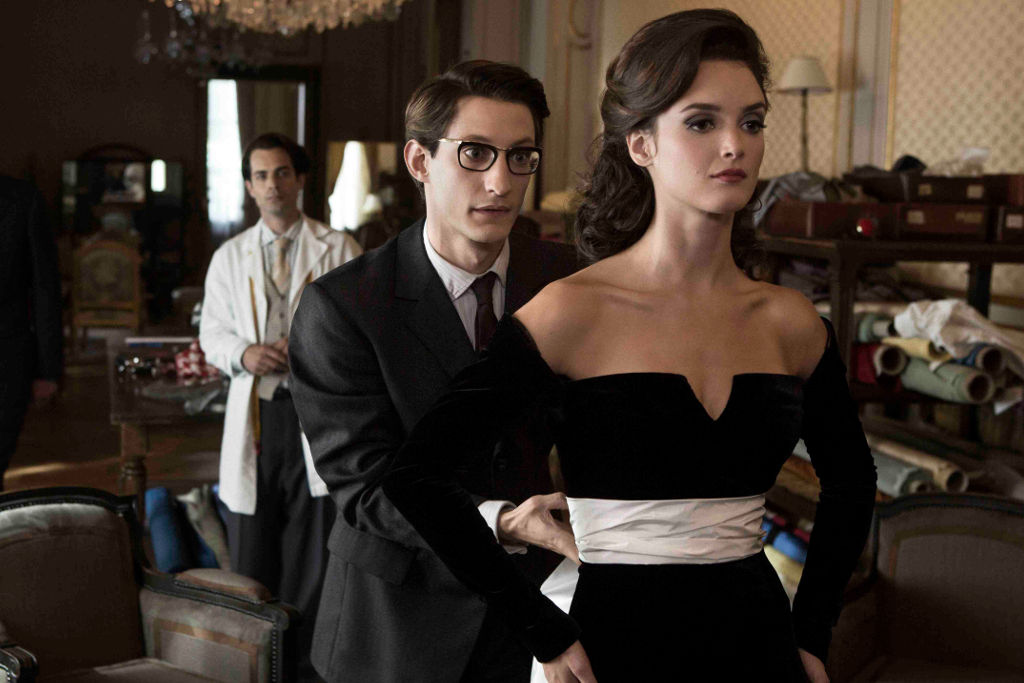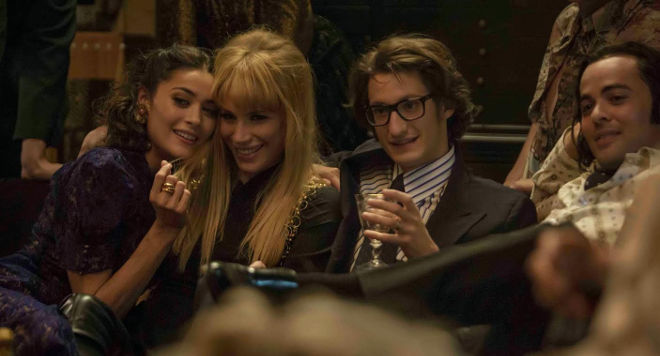The Failure Of ‘Yves Saint Laurent’, And The Perennial Problem With Creative Biopics
They set out to show how a person moved and challenged the public with his or her work -- yet they so rarely move and challenge audiences the same way.

Yves Saint Laurent is a new corporate biopic respectfully directed by Jalil Lespert. It follows the French fashion designer (played by Pierre Niney) from 1958, when he was chosen to succeed Christian Dior at the age of just 21, to the triumphant unveiling of his Ballets Russes collection in 1976.
And it fails dismally to capture – or even to really grasp – what made Saint Laurent interesting and his work significant.
This is an unfortunately common problem with biographical films about creative people; writers, artists, musicians and designers. Beautifully made, soundtracked with melancholy piano melodies and swelling strings, they turn out as stodgy hagiographies my mum might enjoy.
Not that I have a problem with mum-centric cinema. But it’s ironic that these films set out to show how a famous creative person moved and challenged the public with his or her work, yet they so rarely move and challenge audiences the same way.
Who’s Pulling The Strings?
Yves Saint Laurent was authorised by the Pierre Bergé-Yves Saint Laurent Foundation, which costumed the production in real YSL designs from its archive. Pierre Bergé is Saint Laurent’s partner in business and in life, the guardian of his legacy and, as portrayed by Guillaume Gallienne, the true hero of this film.
It’s not unusual for romantic partners to be the wind beneath the wings of creative people. Matt Tyrnauer’s 2008 documentary Valentino: The Last Emperor delightfully shows how Giancarlo Giammetti kept Valentino Garavani’s couture house on the rails, dealing with his tempestuous lover with affectionate patience.
Yves Saint Laurent, however, wants us in Bergé’s corner. Pierre is a dependable sad sack, constantly saving the day yet never rewarded with the fidelity and gratitude of his flighty, brittle paramour. Early on, a delighted Pierre goes to tell Yves they’ve just sold a huge consignment to a major department store, only to find the designer pissfarting around with his favourite model Victoire (Charlotte Le Bon). Cajoled into cooking dinner for Victoire, Pierre rebels, kicking her out of their apartment… but not before hate-fucking her in the hallway. Later, Pierre is tortured by jealousy of Jacques de Bascher (Xavier Lafitte), the toyboy Yves steals from his frenemy Karl Lagerfeld (Nikolai Kinski). There’s something fascinating about the psychosexual politics on display here – the use of sex as revenge, solace and competition, and the passionate undercurrent of platonic attachments between gay men and straight women.
David Cronenberg’s A Dangerous Method is flawed in many ways, but it literalises the Freudian view predominant among creative biopics: that everything we do is driven by formative childhood experiences and subconscious urges. Walt Disney (Tom Hanks) expertly psychoanalyses PL Travers (Emma Thompson) in Saving Mr Banks, steering her towards the cathartic realisation that her Mary Poppins novels reflect her sublimated trauma of growing up with a feckless alcoholic dad (Colin Farrell).
In Yves Saint Laurent, however, Lespert is hamstrung by his authorised story’s demand for discretion and flattery, including sexy stuff seemingly only because it’s a mandatory ingredient in the creative biopic genre. Rather than viewing Saint Laurent ambivalently – as a ruthless person who demanded security and adoration, and punished perceived disloyalty with emotional cruelty – Lespert glosses him as a childish, manic-depressive hedonist whom good old Pierre must rescue from scrapes.
By contrast, in adapting his own freewheeling graphic novel on the life of Serge Gainsbourg into 2010’s Gainsbourg: A Heroic Life, Joann Sfar was free to depart from an authorised narrative. He introduces fantastical elements that would be at home in a Guillermo del Toro film; indeed, del Toro favourite Doug Jones co-stars as Gainsbourg’s Tyler Durden-esque alter ego, La Gueule. Visually captivating and often very funny, Gainsbourg’s joyous irreverence is a fitting tribute to a French legend who basically didn’t give a shit.
–
It Should Be About The Work
Perhaps Yves Saint Laurent’s most egregious error is its lack of interest in his work. It gestures emptily to “the designs that shocked the world” and “the man who revolutionised fashion”, but is much more interested in Saint Laurent’s personal turmoil.
The real Saint Laurent was a trailblazer. He popularised designer perfumes, accessories and ready-to-wear. He experimented radically with proportion and silhouette, put Mondrian prints on shift dresses, created sexy transparent blouses and ‘Le Smoking’ man-style suiting for women, championed ethnically diverse models and fused Western and Eastern sartorial styles.
The problem with depicting the creative process onscreen is that its workings are hidden in the brain. (The recent film Hannah Arendt shows the German intellectual writing her landmark book on the Holocaust by depicting her smoking a lot and staring into space.) So instead, filmmakers must depict the psychological and emotional toll of genius, the dramatic and controversial reception of the subject’s work, and the sublime revelation of creative performance.
Yet the film-Yves is a delicate, painfully shy savant who somehow, mysteriously, manages to invent innovative and controversial looks. From the first moment he adds a dramatic sash to a Dior dress and then just doesn’t explain why, we never feel the impact of his work. We simply see his collection hit the runway and rapt onlookers clap fiercely, misty-eyed. Another YSL triumph! People line up outside boutiques to buy it.
And then it’s back to another risible scene of Yves eating hash candies with his besties in Marrakech and cavorting wastedly trying on scarves, or snorting coke in discos and falling over.
It’s possible for film to show how the creative eye roams and finds its inspiration. The 2009 biopic Coco Avant Chanel follows Gabrielle Chanel’s early years, as she built her reputation on savvy networking and her charm with men. The perfectly cast Audrey Tautou is oddly unsympathetic, but does evocative work with intense black eyes in a pale, makeup-free face.
The camera follows Coco’s gaze, alighting on a nun’s pin-tucked habit, the layered textures of ladies at the races, and fishermen hauling their catch in shapeless jackets and striped T-shirts. It’s a clever way to show that Chanel transformed the quotidian into luxury – and that this, ultimately, is what made her designs so radical.
Choosing Aesthetic Style Over Narrative Stodge
Yves Saint Laurent suffers from the same problem that bedeviled Sagan, the 2008 French biopic of author Françoise Sagan. It adheres rigidly to the clichéd narrative trajectory that creative excellence inevitably robs someone of happiness and health.
Sagan’s first novel, Bonjour Tristesse, made her a teenage sensation in 1954 – and indeed, the newspaper L’Express hailed Saint Laurent as the same kind of enfant triste: a melancholy prodigy whose creativity draws on suffering. Much as poor Françoise descends predictably into addiction and a premature grave, Yves Saint Laurent depicts its protagonist as weary and worn out by only 1976 – so fragile he can barely enjoy the triumph of his successful collection.
Edith Piaf also died dissolute and too young. Yet La Vie en Rose refuses a grim downward chronology. Director Olivier Dahan understands that what made Piaf special was the alchemy she could summon on stage, so his film is structured in vignettes around Piaf’s (Marion Cotillard) key performative moments. And rather than ending with a sick woman dying in bed, the film climaxes as Cotillard triumphantly delivers Piaf’s iconic theme tune, ‘Non, Je Ne Regrette Rien’.
We see another protagonist buffeted by loss and pondering death in the 2009 drama A Single Man. It isn’t a biopic, and it isn’t about fashion, but a fashion designer – Tom Ford – directed this intensely mannered, almost hallucinatory film. In prioritising aesthetics over narrative, it’s dramatic in a vital and moving way.
I was reminded of A Single Man when I saw Coco Chanel and Igor Stravinsky, Jan Kounen’s fictionalised 2009 account of Chanel’s long-rumoured affair with modernist composer Stravinsky, when the penniless Russian émigré and his family stayed at the couturière’s villa outside Paris in 1920. Kounen takes Stravinsky’s uncompromising, controversial Rite Of Spring as the cue for a film that combines stark deco glamour with an emphasis on the animalistic. The film’s re-enactment of the famous riot at the suite’s 1913 Paris premiere has an immediacy that’s truly thrilling to watch – you feel as if you were there.
Elsewhere, Kounen uses dynamic camera angles and, strikingly, splices in portrait-like tableaux and lyrical moments that serve no purpose in terms of plot or character. They are like decorative embellishments on a gown, or baroque flourishes in a melody; they adorn the film, making it shine.
Strikingly, Kounen doesn’t care about making either Stravinsky (Mads Mikkelsen) or Chanel (Anna Mouglalis) seem virtuous or likeable. Theirs is no meeting of minds; it’s a meating of flesh. But Stravinsky and Chanel’s raw talent is what animates the film.
It’s a shame that so few biopics use film’s unique aesthetic qualities to show why we’re drawn to creativity, rather than simply glorying in the high and low moments in creative people’s personal lives.
Psychological torment and sexual antics may look good onscreen, but they don’t explain genius.
–
Yves Saint Laurent is in cinemas now.
–
Mel Campbell is a freelance journalist and cultural critic. She tweets at @incrediblemelk.
